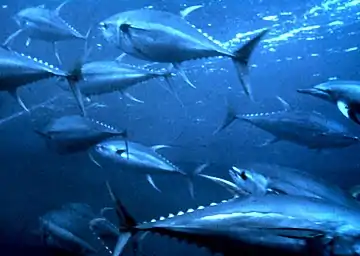Australian Fisheries Management Authority
The Australian Fisheries Management Authority (AFMA) is the Australian Government agency responsible for the management and sustainable use of fisheries resources including combating illegal fishing activities in the Australian Fishing Zone[2][3] that covers 8,148,250 square kilometres, the third largest in the world,[4] and in most of Australia's Exclusive Economic Zone, which extends to 200 nautical miles (370 km) from the coastline of Australia and its external territories, except where a maritime delimitation agreement exists with a state.[5][6]) AFMA is an agency of the Australian Department of Agriculture and Water Resources.[7] The Authority does not have a legal identity separate from the Commonwealth.[8]
| Agency overview | |
|---|---|
| Formed | 1992 |
| Employees | 197 (2015)[1] |
| Parent department | Department of Agriculture and Water Resources |
History
The Australian Fishing Zone (AFZ) was first declared in 1979, and covers Australian waters, generally from 3 nautical miles to 200 nautical miles from the Australian coast.[5] To the 3 nautical miles boundary are state waters and fisheries are managed by the respective states.
The Australian Fisheries Management Authority was established in February 1992 and its operations are governed by the Australian Fisheries Administration Act 1991 (Cth) and Fisheries Management Act 1991 (Cth).
Australia declared an Exclusive Economic Zone (EEZ) on 1 August 1994, which extends to 200 nautical miles from its coastline. To the 12 nautical miles boundary is Australia’s territorial waters.
Current responsibilities

AFMA manages Commonwealth fisheries that are typically within the 200-nautical-mile (370 km) Australian Fishing Zone (AFZ), on the high seas, and, in some cases, by agreement with other Australian States to the low water mark.
The agency is also responsible for combating illegal fishing in Australia's Exclusive Economic Zone including the waters between Australia and Indonesia and in the Southern Ocean and the Australian territories of Ashmore and Cartier Islands and Heard Island and McDonald Islands.[9] This activity is conducted with the assistance of the Australian Customs and Border Protection Service and the Australian Navy.
Agency structure
AFMA operates under the direction of a Commission and a Chief Executive Officer, who is also a Commissioner.
The Commission is responsible for domestic fisheries management while the Chief Executive Officer is responsible for foreign fisheries compliance, under direction from the Australian Government
All Commissioners, apart from the CEO, are appointed on a remunerated, part-time basis. The current Chair of the Commission is Helen Kroger. Helen has held leadership positions in the private, public and not for profit sectors for the last 20 years. She is a former Liberal Senator for Victoria, Government Whip and active former member of numerous key Senate and Joint Committees. She has extensive board experience and advises corporations on regulatory and compliance, governance, communications and stakeholder management issues..[10]
References
- "Table 2". APS Statistical Bulletin 2014-15 (Report). Australian Public Service Commission. Archived from the original on 2016-04-23. Retrieved 2016-04-08.
- Australian Fisheries Management Authority, Combating illegal fishing
- Australian Fisheries Management Authority
- Bray, Dianne. "Commercial Fishing". Fishes of Australia. Retrieved 30 September 2014.
- The Australian Fishing Zone
- Geoscience Australia. 2005. Maritime Boundary Definitions Archived 2005-04-05 at the Wayback Machine.Comlaw.gov.au
- AFMA - History Archived May 14, 2009, at the Wayback Machine
- Section 5 Fisheries Administration Act 1991
- AFMA - About AFMA



